Parameter Optimization for Printing Barium Titanate Piezoelectric Ceramics through Digital Light Processing
Abstract
:1. Introduction
2. Material and Methods
2.1. Raw Materials
2.2. Slurry Preparation
2.3. DLP Printing Program
2.4. Green Body Post-Treatment Process
2.5. Characterization and Testing
3. Results and Discussion
3.1. Effects of Solid Content on Curing Depth
3.2. Effects of the Heat Treatment Process
3.3. Effect of Poling Process
3.4. Print Example: Preparation of Sensor Components
4. Conclusions
Author Contributions
Funding
Data Availability Statement
Conflicts of Interest
References
- Cai, K.; Jiao, Y.; Quan, Q.; Hao, Y.; Liu, J.; Wu, L. Improved activity of MC3T3-E1 cells by the exciting piezoelectric BaTiO3/TC4 using low-intensity pulsed ultrasound. Bioact. Mater. 2021, 6, 4073–4082. [Google Scholar] [CrossRef]
- Collins, M.N.; Ren, G.; Young, K.; Pina, S.; Rui, L.R.; Oliveira, J.M. Scaffold Fabrication Technologies and Structure/Function Properties in Bone Tissue Engineering. Adv. Funct. Mater. 2021, 31, 2010609. [Google Scholar] [CrossRef]
- Masmanidis, S.C.; Karabalin, R.B.; Vlaminck, I.D.; Borghs, G.; Freeman, M.R.; Roukes, M.L. Multifunctional Nanomechanical Systems via Tunably Coupled Piezoelectric Actuation. Science 2007, 317, 780–783. [Google Scholar] [CrossRef]
- Park, D.Y.; Joe, D.J.; Kim, D.H.; Park, H.; Han, J.H.; Jeong, C.K.; Park, H.; Park, J.G.; Joung, B.; Lee, K.J. Self-Powered Real-Time Arterial Pulse Monitoring Using Ultrathin Epidermal Piezoelectric Sensors. Adv. Mater. 2017, 29, 1702308. [Google Scholar] [CrossRef]
- Zheng, T.; Zhang, Y.; Ke, Q.; Wu, H.; Wu, J. High-performance Potassium Sodium Niobate Piezoceramics for Ultrasonic Transducer. Nano Energy 2020, 70, 104559. [Google Scholar] [CrossRef]
- Yan, X.; Zheng, M.; Zhu, M.; Hou, Y. A low frequency lead-free piezoelectric energy harvester with high power density. J. Am. Ceram. Soc. 2019, 102, 3085–3089. [Google Scholar] [CrossRef]
- Tadashi, T.; Hajime, N. Current status and prospects of lead-free piezoelectric ceramics. J. Eur. Ceram. Soc. 2005, 25, 2693–2700. [Google Scholar]
- Tomoaki, K.; Kang, Y.; Toshiyuki, M.; Masatoshi, A. Lead-Free Piezoelectric Ceramics with Large Dielectric and Piezoelectric Constants Manufactured from BaTiO3 Nano-Powder. Jpn. J. Appl. Phys. 2007, 46, L97. [Google Scholar]
- Bae, C.J.; Ramachandran, A.; Halloran, J.W. Quantifying Particle Segregation in Sequential Layers fabricated by Additive Manufacturing. J. Eur. Ceram. Soc. 2018, 38, 4082–4088. [Google Scholar] [CrossRef]
- Cjb, A.; Jwh, B. Concentrated suspension-based additive manufacturing–viscosity, packing density, and segregation-ScienceDirect. J. Eur. Ceram. Soc. 2019, 39, 4299–4306. [Google Scholar]
- Kim, K.; Zhu, W.; Qu, X.; Aaronson, C.; McCall, W.R.; Chen, S.; Sirbuly, D.J. 3D Optical Printing of Piezoelectric Nanoparticle–Polymer Composite Materials. ACS Nano 2014, 8, 9799. [Google Scholar] [CrossRef]
- Kim, H.; Renteria-Marquez, A.; Islam, M.D.; Chavez, L.A.; Garcia Rosales, C.A.; Ahsan, M.A.; Tseng, T.L.B.; Love, N.D.; Lin, Y. Fabrication of Bulk Piezoelectric and Dielectric BaTiO3 Ceramics using Paste Extrusion 3D Printing Technique. J. Am. Ceram. Society 2018, 102, 3685–3694. [Google Scholar] [CrossRef]
- Mcnulty, T.F.; Shanefield, D.J.; Danforth, S.C.; Safari, A. Dispersion of Lead Zirconate Titanate for Fused Deposition of Ceramics. J. Am. Ceram. Soc. 1999, 82, 1757–1760. [Google Scholar] [CrossRef]
- Lous, G.M.; Cornejo, I.A.; Mcnulty, T.F.; Safari, A.; Danforth, S.C. Fabrication of Piezoelectric Ceramic/Polymer Composite Transducers Using Fused Deposition of Ceramics. J. Am. Ceram. Soc. 1998, 542, 124–128. [Google Scholar] [CrossRef]
- Bandyopadhyay, A.; Panda, R.K.; Janas, V.F. Processing of Piezocomposites by Fused Deposition Technique. J. Am. Ceram. Soc. 1997, 80, 999–1002. [Google Scholar] [CrossRef]
- Malakooti, M.H.J.; FlorianSodano Henry, A. Printed Nanocomposite Energy Harvesters with Controlled Alignment of Barium Titanate Nanowires. ACS Appl. Mater. Interfaces 2018, 10, 38359–38367. [Google Scholar] [CrossRef]
- Lim, J.; Jung, H.; Baek, C.; Hwang, G.T.; Ryu, J.; Yoon, D.; Yoo, J.; Park, K.I.; Kim, J.H. All-inkjet-printed flexible piezoelectric generator made of solvent evaporation assisted BaTiO3 hybrid material. Nano Energy 2017, 41, 337–343. [Google Scholar] [CrossRef]
- Tesavibul, P.; Felzmann, R.; Gruber, S.; Liska, R.; Thompson, I.; Boccaccini, A.R.; Stampfl, J. Processing of 45S5 Bioglass (R) by lithography-based additive manufacturing. Mater. Lett. 2012, 74, 81–84. [Google Scholar] [CrossRef]
- Hatzenbichler, M.; Geppert, M.; Gruber, S.; Ipp, E.; Stampfl, J. DLP-based light engines for additive manufacturing of ceramic parts. Proc. SPIE-Int. Soc. Opt. Eng. 2012, 8254, 11. [Google Scholar]
- Felzmann, R.; Gruber, S.; Mitteramskogler, G.; Tesavibul, P.; Boccaccini, A.R.; Liska, R.; Stampfl, J. Lithography-Based Additive Manufacturing of Cellular Ceramic Structures. Adv. Eng. Mater. 2012, 14, 1052–1058. [Google Scholar] [CrossRef]
- Sun, J.; Chen, X.; Wade-Zhu, J.; Binner, J.; Bai, J. A comprehensive study of dense zirconia components fabricated by additive manufacturing. Addit. Manuf. 2021, 2, 101994. [Google Scholar] [CrossRef]
- Shah, D.M.; Morris, J.; Plaisted, T.A.; Amirkhizi, A.V.; Hansen, C.J. Highly filled resins for DLP-based printing of low density, high modulus materials. Addit. Manuf. 2020, 37, 101736. [Google Scholar] [CrossRef]
- He, R.; Wei, L.; Wu, Z.; Di, A.; Xie, Z. Fabrication of Complex-shaped Zirconia Ceramic Parts via a DLP- Stereolithography-based 3D printing method. Ceram. Int. 2017, 44, 3412–3416. [Google Scholar] [CrossRef]
- Gmeiner, R.; Mitteramskogler, G.; Stampfl, J.; Boccaccini, A.R. Stereolithographic ceramic manufacturing of high strength bioactive glass. Int. J. Appl. Ceram. Technol. 2015, 12, 38–45. [Google Scholar] [CrossRef]
- Liu, S.; Mo, L.; Bi, G.; Chen, S.; Yan, D.; Yang, J.; Jia, Y.G.; Ren, L. DLP 3D printing porous β-tricalcium phosphate scaffold by the use of acrylate/ceramic composite slurry. Ceram. Int. 2021, 47, 21108–21116. [Google Scholar] [CrossRef]
- Sotov, A.; Popovich, A.; Sufiiarov, V. LCD-SLA 3D printing of BaTiO3 piezoelectric ceramics. Ceram. Int. 2021, 47, 30358–30366. [Google Scholar] [CrossRef]
- Wang, W.; Sun, J.; Guo, B.; Chen, X.; Ananth, K.P.; Bai, J. Fabrication of piezoelectric nano-ceramics via stereolithography of low viscous and non-aqueous suspensions. J. Eur. Ceram. Soc. 2020, 40, 682–688. [Google Scholar] [CrossRef]
- Cheng, J.; Chen, Y.; Wu, J.-W.; Ji, X.-R.; Wu, S.-H. 3D printing of BaTiO3 piezoelectric ceramics for a focused ultrasonic array. Sensors 2019, 19, 4078. [Google Scholar] [CrossRef]
- Zhou, M.; Liu, W.; Wu, H.; Song, X.; Chen, Y.; Cheng, L.; He, F.; Chen, S.; Wu, S. Preparation of a defect-free alumina cutting tool via additive manufacturing based on stereolithography–Optimization of the drying and debinding processes. Ceram. Int. 2016, 42, 11598–11602. [Google Scholar] [CrossRef]
- Jiang, Z.; Cheng, L.; Zeng, Y.; Zhang, Z.; Zhao, Y.; Dong, P.; Chen, J. 3D printing of porous scaffolds BaTiO 3 piezoelectric ceramics and regulation of their mechanical and electrical properties. Ceram. Int. 2022, 48, 6477–6487. [Google Scholar] [CrossRef]
- Liu, K.; Hu, J.; Du, Y.; Shi, Y.; Sun, Y.; Zhang, S.; Tu, R.; Zhang, Q.; Huang, S.; Sun, H. Influence of particle size on 3D-printed piezoelectric ceramics via digital light processing with furnace sintering. Int. J. Appl. Ceram. Technol. 2022, 19, 2461–2471. [Google Scholar] [CrossRef]
- Chen, X.; Sun, J.; Guo, B.; Wang, Y.; Yu, S. Effect of the particle size on the performance of BaTiO3 piezoelectric ceramics produced by additive manufacturing. Ceram. Int. 2022, 48, 1285–1292. [Google Scholar] [CrossRef]
- Ma, J.; Zhu, K.; Huo, D.; Shen, B.; Liu, Y.; Qi, X.; Sun, E.; Zhang, R. Performance enhancement of 1-3 piezoelectric composite materials by alternating current polarising. Ceram. Int. 2021, 47, 18405–18410. [Google Scholar] [CrossRef]
- Lu, H.; Cui, H.; Lu, G.; Jiang, L.; Hensleigh, R.; Zeng, Y.; Rayes, A.; Panduranga, M.K.; Acharya, M.; Wang, Z.; et al. 3D Printing and processing of miniaturized transducers with near-pristine piezoelectric ceramics for localized cavitation. Nat. Commun. 2023, 14, 2418. [Google Scholar] [CrossRef]

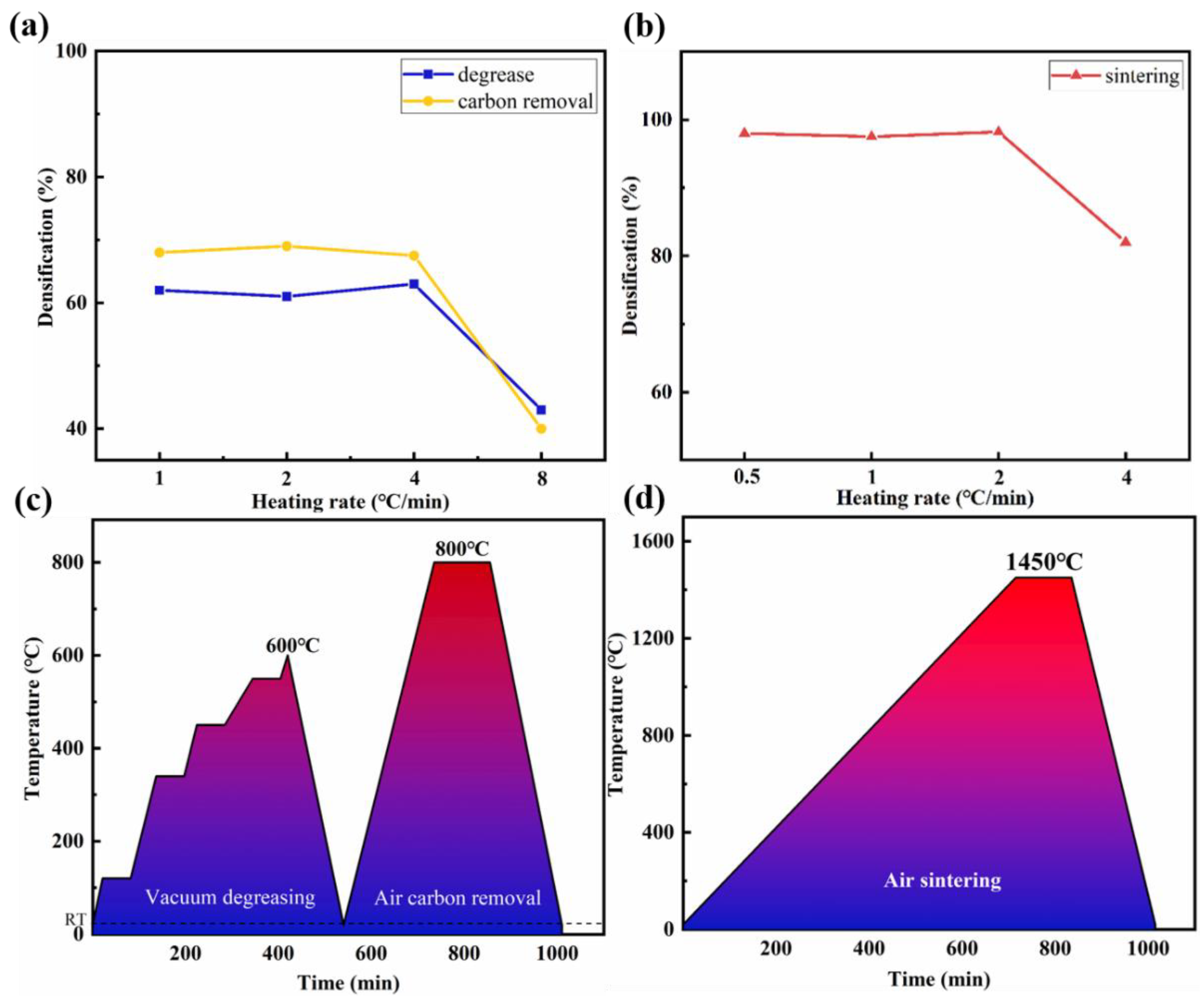
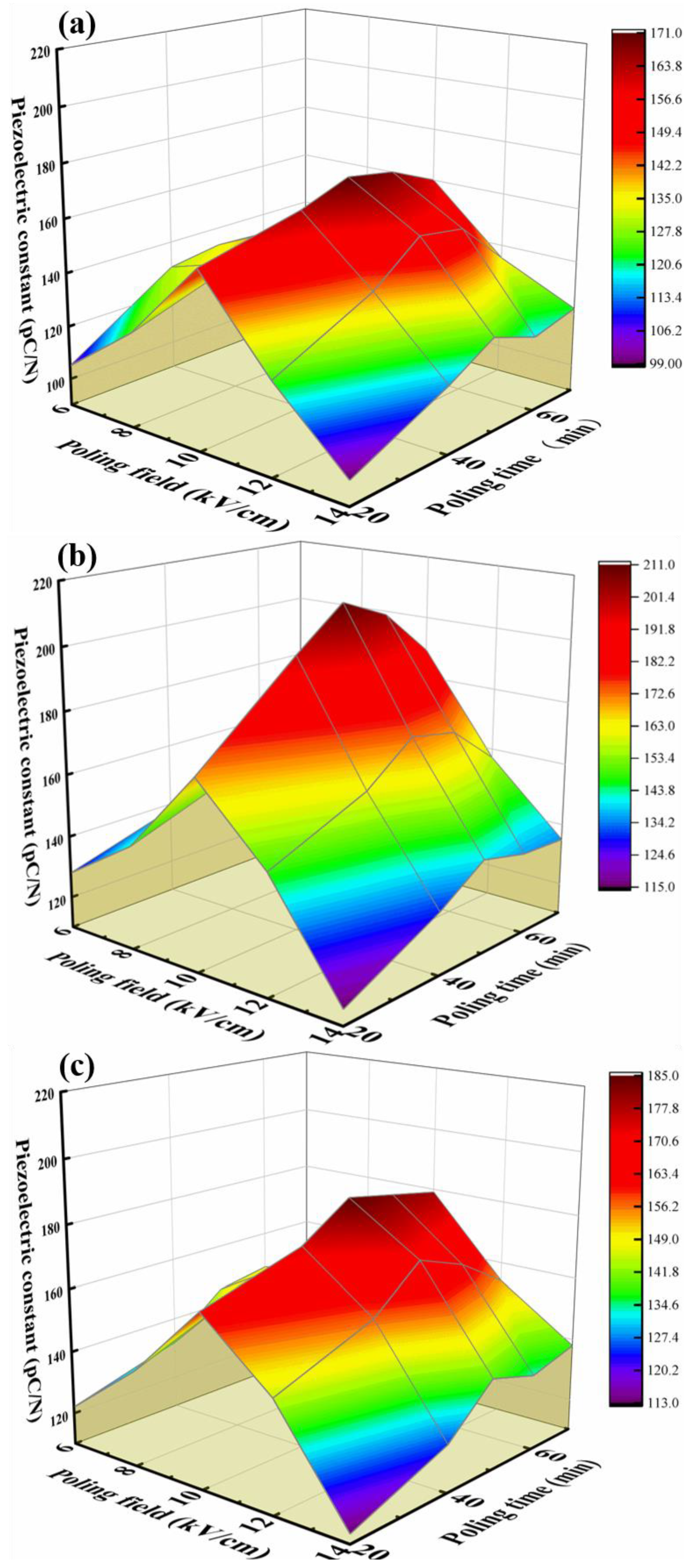
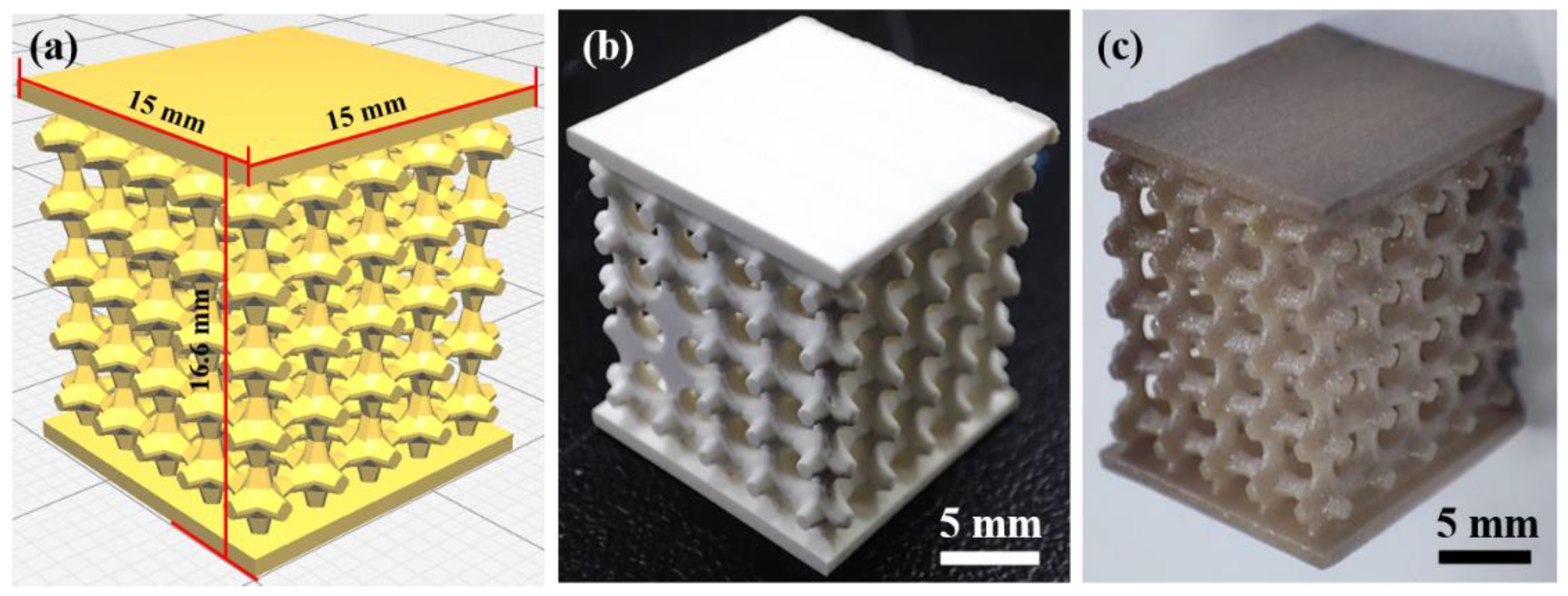
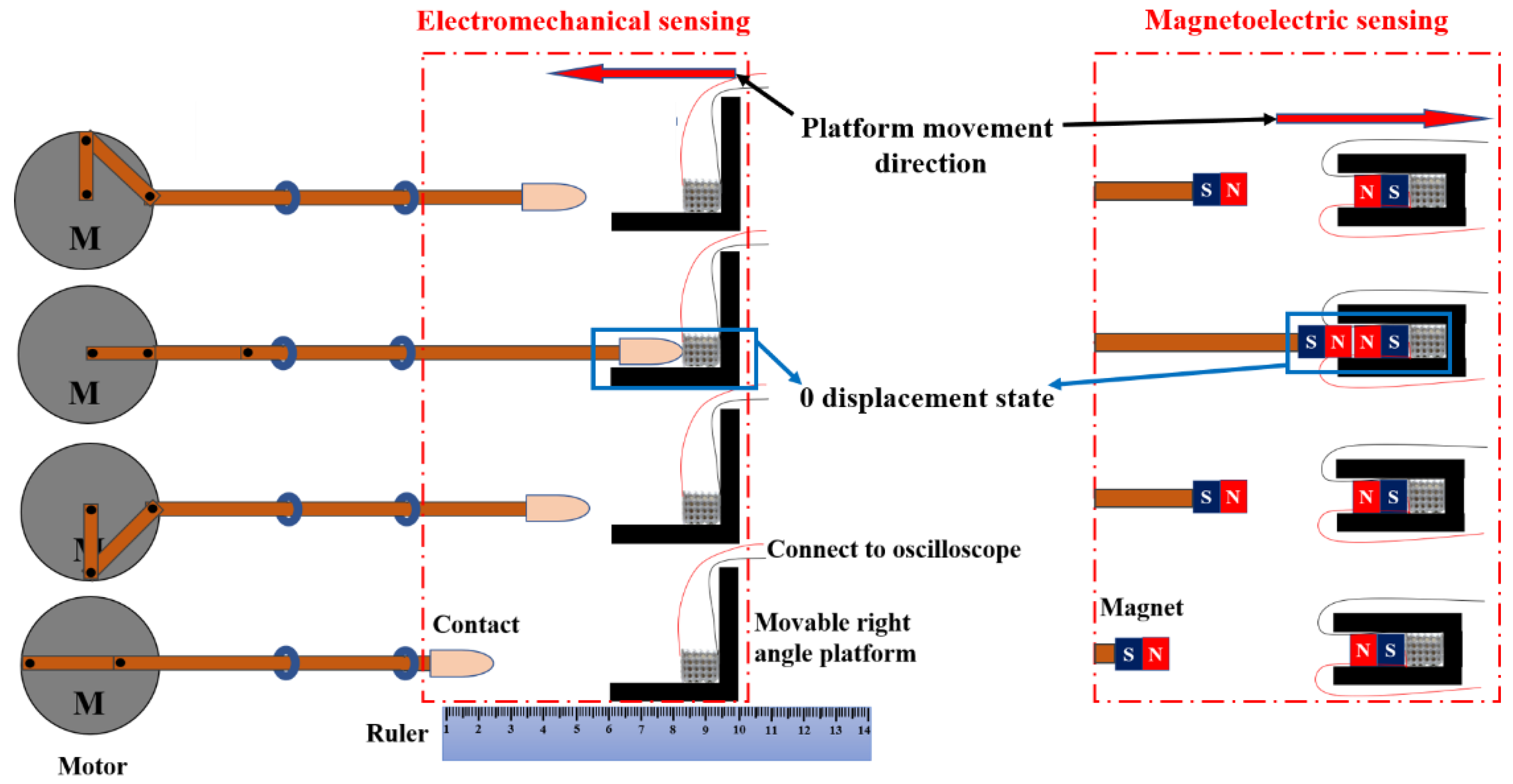
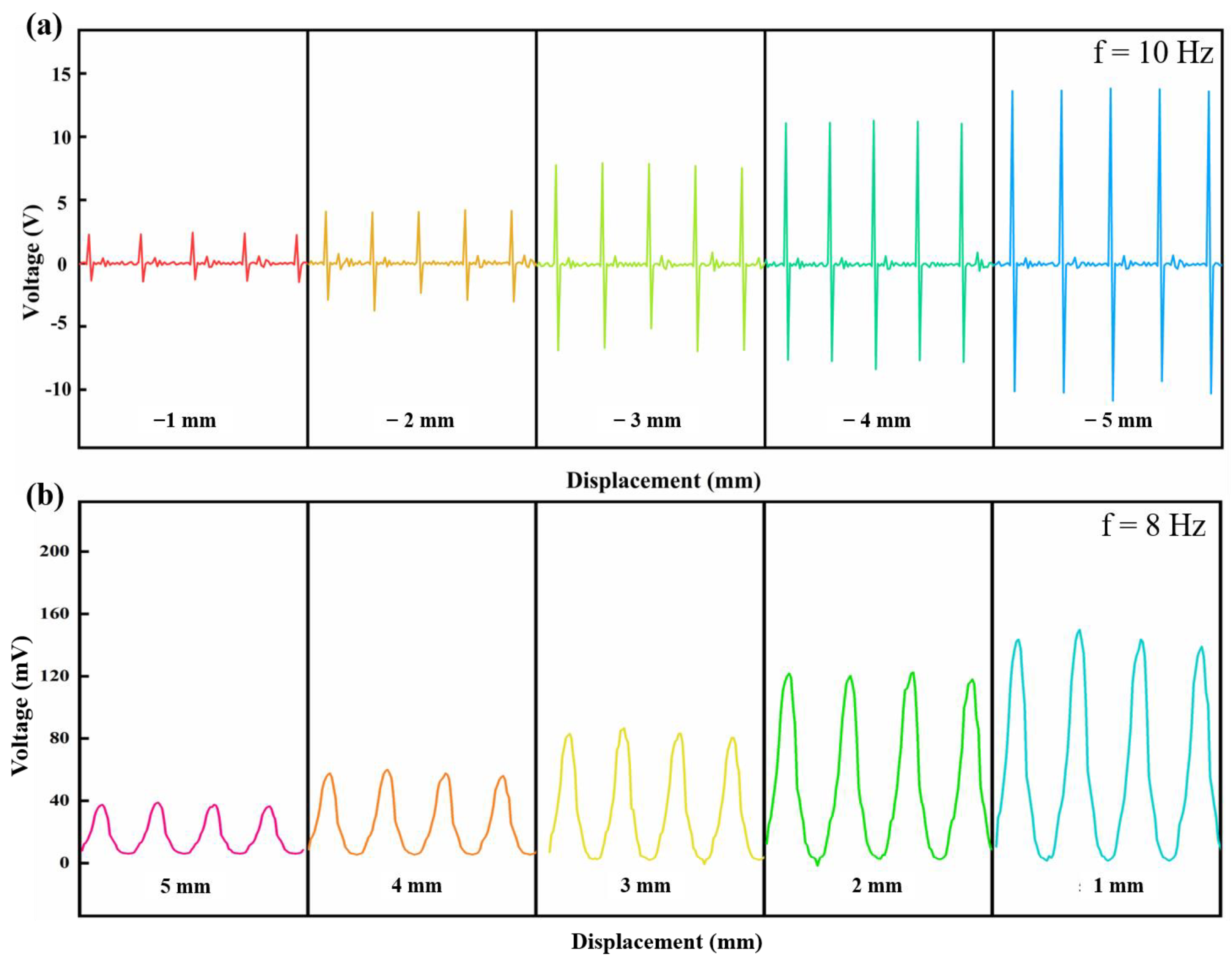
| Process Parameters | Optimized Values |
|---|---|
| Solid content | 75 wt% |
| Curing time | 5 s |
| Degreasing heating rate | 4 °C/min |
| Carbon removal heating rate | 4 °C/min |
| Sintering heating rate | 2 °C/min |
| Poling field | 10 kV/cm |
| Poling time | 50 min |
| Poling temperature | 60 °C |
Disclaimer/Publisher’s Note: The statements, opinions and data contained in all publications are solely those of the individual author(s) and contributor(s) and not of MDPI and/or the editor(s). MDPI and/or the editor(s) disclaim responsibility for any injury to people or property resulting from any ideas, methods, instructions or products referred to in the content. |
© 2023 by the authors. Licensee MDPI, Basel, Switzerland. This article is an open access article distributed under the terms and conditions of the Creative Commons Attribution (CC BY) license (https://creativecommons.org/licenses/by/4.0/).
Share and Cite
Zhang, D.; Yang, Y.; Rao, W.-F. Parameter Optimization for Printing Barium Titanate Piezoelectric Ceramics through Digital Light Processing. Micromachines 2023, 14, 1146. https://doi.org/10.3390/mi14061146
Zhang D, Yang Y, Rao W-F. Parameter Optimization for Printing Barium Titanate Piezoelectric Ceramics through Digital Light Processing. Micromachines. 2023; 14(6):1146. https://doi.org/10.3390/mi14061146
Chicago/Turabian StyleZhang, Dongcai, Yaodong Yang, and Wei-Feng Rao. 2023. "Parameter Optimization for Printing Barium Titanate Piezoelectric Ceramics through Digital Light Processing" Micromachines 14, no. 6: 1146. https://doi.org/10.3390/mi14061146






